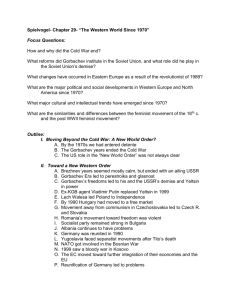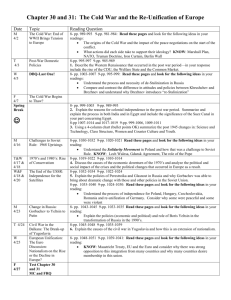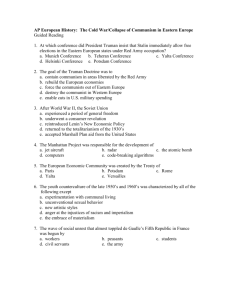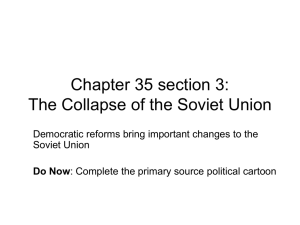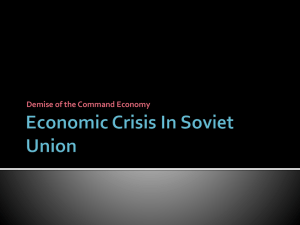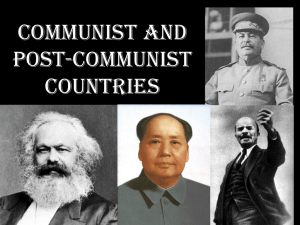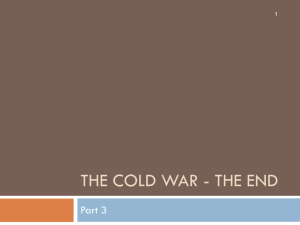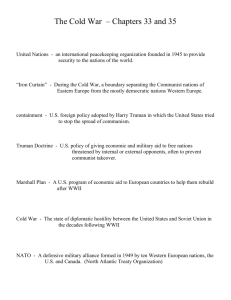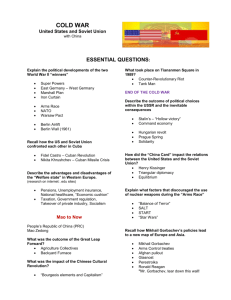Debate slideshow-capitalism history
advertisement
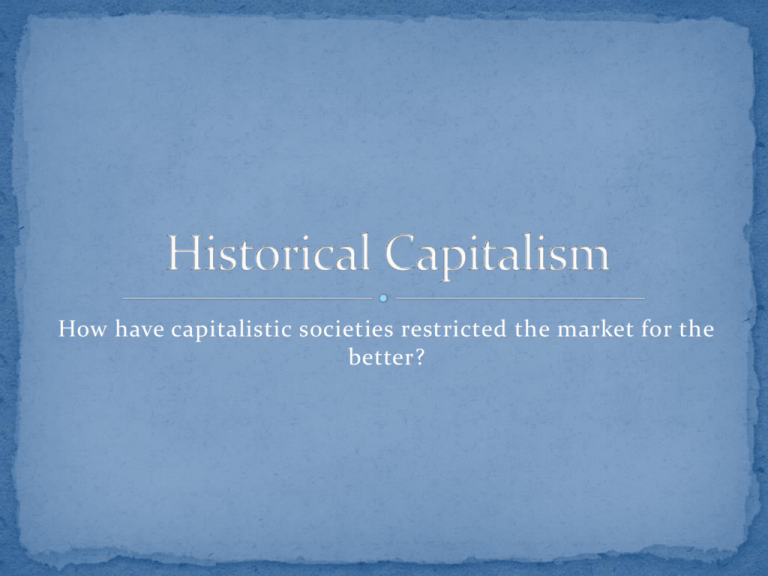
How have capitalistic societies restricted the market for the better? “After World War II, the Communists under MAO Zedong established an autocratic socialist system that, while ensuring China's sovereignty, imposed strict controls over everyday life and cost the lives of tens of millions of people. After 1978, MAO's successor DENG Xiaoping and other leaders focused on marketoriented economic development and by 2000 output had quadrupled. For much of the population, living standards have improved dramatically and the room for personal choice has expanded, yet political controls remain tight. China since the early 1990s has increased its global outreach and participation in international organizations.” (CIA world factbook) Since the late 1970s, China has transitioned from a closed, centrally planned system (i.e. purely communist) to a more market-oriented economy by: Phasing out collective farming (joint production) Gradual liberalization of prices Fiscal decentralization (taxes to local, rather than central, government) Increasing autonomy of state enterprises Creating diversified banking system Developing stock markets Increasing private sector Opening up to foreign trade and investment In short, they basically realized that they needed a free market economy and reformed their central government to have less power and accept foreign markets. The government is still communist, but the economy is market-oriented. The reconstructing of the economy has created better efficiency, resulting in a tenfold increase in GDP (Gross Domestic Product) since 1978. As far as purchasing power parity (PPP), China currently has the second-largest economy after the US The dollar values of China’s agricultural and industrial output exceed those of the US In the midst of economic recession, China’s economy is still growing In 2010, China outperformed all other major economies with GDP growth of about 10% China was 1% of the world economy in 1970; in 2007 it was 6% (the third biggest) Per capita income is below the world average Because of the “one child” policy, China is one of the most rapidly aging countries in the world, meaning that at some point in the near future, there will be too many people too old to work to be supported by the working generations. China’s GDP in 2010 was $9.872 trillion for purchasing power parity and $5.745 trillion for official exchange rate—3 rd in world (US is 14.72 trillion) 2010 GDP growth rate 10.3%, 8 th highest growth rate Largest labor force in the world (780 million) Household income percentage: Lowest 10%—3.5% Highest 10%—15% Public debt: 17.5% (113th) 4th highest market value of traded shares (5.008 trillion) Switch to market economy Switch to market economy Per capita income: $7,400, 127 th in the world GDP by sector: o Agriculture: 9.6% o Industry: 46.8% o Services: 43.6% Labor Force division: o Agriculture: 38.1% o Industry: 27.8% o Services: 34.1% o Notice the disproportion between the percentage of money in labour sectors compared with the percentage of the population working in those fields… Population below poverty line: 2.8% 21.5 million rural below “absolute poverty” line, $90 per year 35.5 million rural below “low income” line, $125 per year Unemployment in urban areas 4.3% (39th in world) According to the CIA, there is substantial unemployment and underemployment in rural areas Reduce high domestic savings rate and correspondingly low domestic demand Sustaining adequate job growth for its population Reduce corruption in the economic spheres Containing environmental damage Notice that none of these are problems with the market system… It’s hard to point on one thing that caused the fall of the USSR, since it was a combination of faulty leadership, economic troubles, and corruption. People always blame Gorbachev, but he was in an awful situation. According to the BBC, “Gorbachev hastened the decline of the Soviet Union, but it was in serious trouble before he came on the scene, and maybe no-one could have saved it.” Gorbachev’s fatal flaw was that he could democratize Leninism. He felt Western consumer goods were superior and would help the Soviet economy. He destroyed the fear of the USSR that was in its people, and the people were then able to get out. However, the USSR was declining for years before Gorbachev. Because of economic decline, Soviet powers had to withdraw from Eastern Europe and Afghanistan and halt the arms race. Gorbachev became leader in March 1985. He introduced 2 new terms: “perestroika” (restructuring) and “glasnost” (openness), hoping for change in a stagnant and socially closed nation Dec 1985—Gorbachev appoints Shevardnadze as foreign minister. Both seek to create a more liberal and dynamic society. He also appoints Yeltsin as head of the Moscow Communist Party. Yeltsin wants change and so begins to fire officials and remove privileges from party supporters. 1987—Gorbachev proposes political and economic reforms, including bringing democratic ideas within the Communist party. He publishes a book on social change. Yeltsin is forced out of his job for pushing perestroika too quickly. Yeltsin is mad, but stays in Moscow as deputy construction minister. 1988—Perestroika hits stumbling block: communist newspaper asks party supporters to resist it. Estonia, Latvia, and Lithuania create political parties. Inter-ethnic unrest in Azerbaijan, also violence in Georgia. Reagan visits Moscow, Gorbachev proposes new presidency and elected parliament. March 1989—Elections held for Gorbachev’s new parliament, called the Congress of People’s Deputies. Yeltsin wins in an election. At first, parliament is filmed and broadcasted live, but this is removed because people stop working to watch. Gorbachev pulls the last of the Soviet troops out of the unpopular war in Afghanistan. People like him. However, two weeks after elections, a peaceful demonstration in Georgia is broken up by Soviet troops, who use poisonous gas and sharpened shovels (they were ordered not to shoot) and kill 19 people, mostly women. Gorbachev denies any prior knowledge of this. July 1989—Gorbachev gives freedom to countries in the Warsaw Pact to decide their own futures. Poland votes out the communist party. Hungary opens its borders to the West, many East Europeans flood to Austria. Nov 1989—Berlin Wall torn down. Gorbachev chooses not to act. Czechoslovakia breaks free with a “Velvet Revolution,” ousting the communists without bloodshed and installing playwright Vaclav Havel as preident. The Romanians revolt, with bloodshed, and the communist president and his wife are overthrown and executed on Christmas Day. Gorbachev is becoming less popular in the USSR, shortages have worsened since perestroika and living standards are decreasing. People are dissatisfied with perestroika. Jan 1990—Gorbachev seeks support of the Baltic states for looser but still Soviet federation. Soviet troops bread up demonstrations in Azerbaijan, killing at least 100 people. Gorbachev’s reforms continue and he eventually strips the Communist Party of its monopoly on government, allowing multi-party politics. Gorbachev becomes president of the USSR (before, all leaders were general secretaries). July 1990—Yeltsin resigns from the Communist Party. Ukraine, Armenia, Turkmenistan, and Tajikistan declare sovereignty. Gorbachev receives Nobel Peace Prize, Germany reunited. Back in the USSR, Gorbachev has to fix the economic problems; he has to choose between a radical reform and a more cautious approach and tries to merge them. Yeltsin criticizes him, no one is happy. Gorbachev decides that nationalism would be bad and that “firm” rule is needed. Shevardnadze resigns, fearing a dictatorship. Gorbachev tries hard-line policies. June 1991—Russians get to vote for a new president and elect Yeltsin. Yeltsin, Gorbachev, and the communist old guard all want power. In January, Soviet troops acted against Lithuania and Latvia, killing at least two dozen. The Baltic states want out, but the majority in the Soviet Union want a reformed union to be retained. 19 August 1991—Gorbachev is about to sign a deal with the republics to give them more freedom. On the morning of the 19th, plotters (made up of some of Gorbachev’s closest colleagues, military chiefs, and the head of the KGB) act: tanks enter Moscow, emergency law is imposed, and many newspapers are closed. Gorbachev, meanwhile, is on holiday. He is put under house arrest and cut off from the world, and the plotters announce that he is ill. Yeltsin rushes to Parliament and begins a resistance. Thousands of demonstrators support him as he defies the tanks and the plotters. People love him. 21-22 August 1991—Gorbachev returns to Moscow. Plotter’s coup collapsed on the 21st because of public opposition and the armed forces’ reluctance to support the plotters. Protesters were protecting Yeltsin and rain prevented air attack. Yeltsin restores Gorbachev to power. Gorbachev learns that his own people were plotting against him and Yeltsin orders him to end the presence of the Soviet Communist Party. On the 22nd, Gorbachev resigns as general secretary and dissolves the Central Committee of the Party. The Russian flag flies alongside the Soviet flag. Late 1991—Moscow recognizes the sovereignty of the Baltic states on 6 September. Ukraine, Armenia, Georgia, and Moldova break away. The leaders of Ukraine, Russia, and Belarus meet to plan a new union and agree on 8 December to disband the USSR and form the Commonwealth of Independent States. On Christmas Day, Gorbachev announces he is stepping down as Soviet president. The Soviet flag is lowered from the Kremlin and the Russian Federation flag flies instead; the USSR is no more. Since the fall of the USSR, Russia has moved from a globally-isolated, centrally-planned economy to a more market-based and globally-integrated economy. In the 1990s, reforms privatized most industry, except energy and defense-related sectors. In 2009, Russia was the world’s largest exporter of natural gas, second largest for oil, third largest for steel and aluminum. Because exportation is so crucial to the economy, Russia is very vulnerable to boom and bust cycles. Since 2007, the government has tried to reduce this dependency by increasing the technology sectors, but there are few results so far. Since 1998, the economy has averaged 7% growth, resulting in a doubling of real disposable incomes and the emergence of a middle class. The economy, however, was hit hard in the 2008-09 economic crisis. In late 2008, the government spent onethird of its $600 billion international reserves (3rd largest in the world) to protect the vale of the ruble and spent $200 billion trying to increase liquidity in the banking sector. The economic decline evened out in 2009 and the economy began to grow again, but a severe drought and fires in central Russia reduced agricultural output, creating a ban on grain exports for part of the year and slowing the growth of manufacturing and retail trade. High oil prices helped growth in the first quarter of 2011 and this could help reduce Russia’s budget deficit from 2008-09, but inflation and increased government spending may limit the positive impact. Longterm challenges: shrinking workforce, high level of corruption, difficulty accessing capital for smaller, nonenergy companies, poor infrastructure in need of large investments. Lack of incentive for the people to work. One Soviet said: “They pretend to pay us and we pretend to work.” In the mid 1980s, about 70% of the industrial output of the USSR went to the military. In the 1930s, when Stalin collectivized farming, an estimated 14 million people died from famine. The Soviets produced false information saying their economy was growing, that the markets were overflowing with food, and by putting funds into the space race and launching Sputnik in 1958 and the first man in space in 1961, it appeared that communism was working and might even surpass the market economy. However, the CIA under the Reagan administration discovered that in actuality the Soviet economy was one quarter or even one half of the US economy. In 1988, the Soviets admitted a $58 billion deficit. GDP in 2010 purchasing power parity 2.229 trillion (7th in world), official exchange rate 1.477 trillion GDP growth rate 2010 3.8% (94th), but in 2009 it was -7.9% and in 2008 5.2% GDP per capita $15,900 (71st) GDP composition by sector: Agriculture: 4.2% Industry: 33.8% Services: 62% Labor Force division: Agriculture: 10% Industry: 31.9% Services: 58.1% Unemployment: 7.6% (83) 13.1% population below poverty line Household income (consumption by percetage share): Lowest 10%: 1.9% Higest 10%: 30.4% Debt: 480.2 billion (22nd) A market economy rests on private property and competitive markets, profits are the criterion for survival. This encourages freedom of choice and motivation to work, which creates wealth. However, humans beings are competitive, greedy, and selfcentered, and capitalism is dependent on a person’s consumerism and egocentric point of view (when the economy’s in trouble, the government gives people money to buy new and better things). We can’t argue that excessive consumerism, greed, and selfcenteredness are in line with Jesus teachings. Buying the newest model of the iPod every 6 months is great for stimulating the economy, but is not justified by any biblical means. How do we deal with this? As we see in China, the overall economy has gotten better with a free market economy, but because the country is so populous, there are still a significant amount of people living below poverty (21.5 million people)—it’s only because the country is so large that this percentage seems trivial (2.15%). Of course, this can be blamed on corruption and overpopulation, and the free market has definitely allowed for there to be less people under the poverty line than before. “Within a Christian perspective, the process of wealth creation has legitimacy and … while the Christian gospel cannot and should not used to baptise any historical economic system, the market economy offers a better starting point than most other systems as well as providing an enormous opportunity for Christians in business to create structures at work which are authentically Christian.” (Griffiths, 14) Production of wealth allows us to create systems to help the poor
